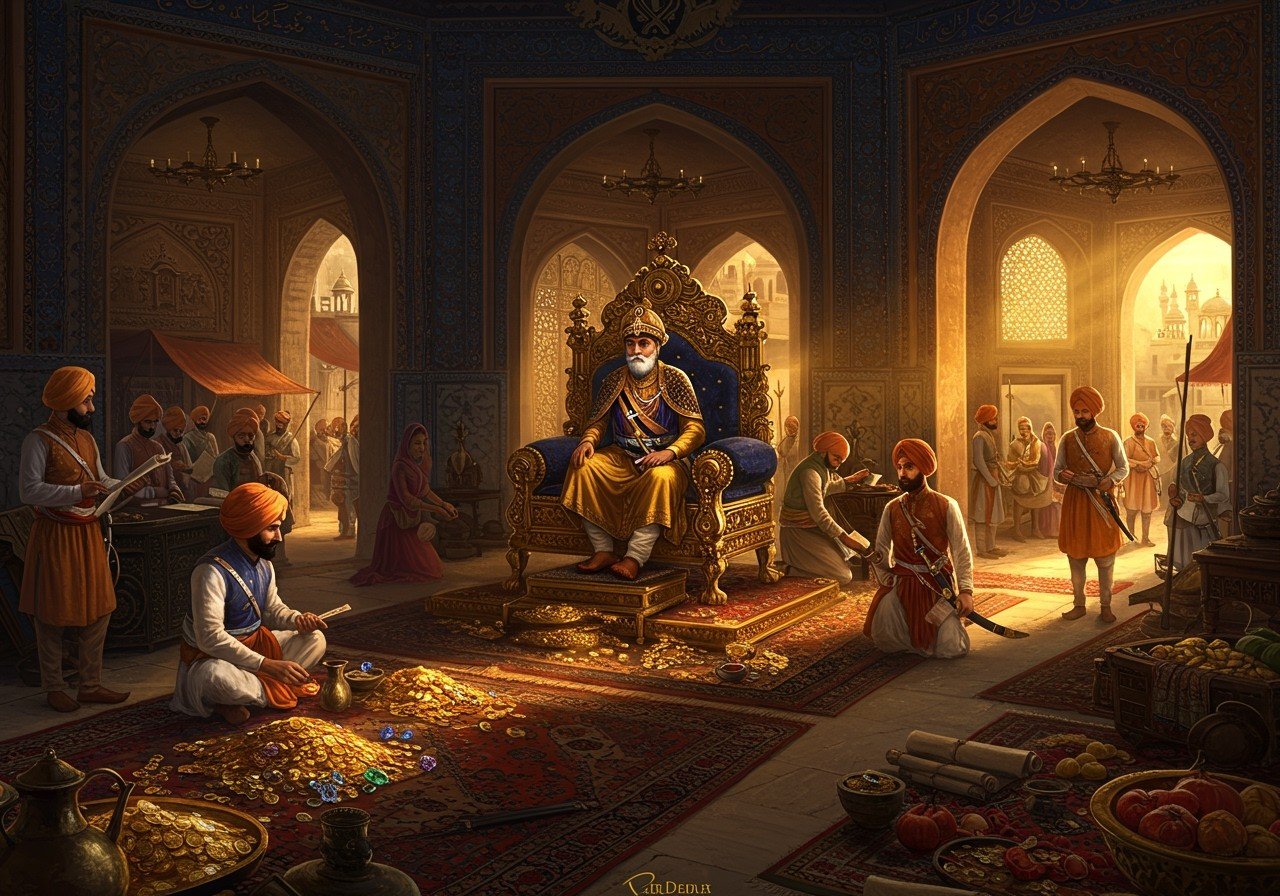The Sikh Empire: Administration, Economy, and Legacy (1799-1849)

The Sikh Empire, established by Maharaja Ranjit Singh in 1799, held a prominent position in the Indian subcontinent until 1849. Known for its formidable military prowess and distinctive governance, the empire stretched across Punjab, encompassing regions within modern-day Pakistan and northern India. This article delves into the intricacies of the Sikh Empire’s administration and economy, providing insights into its governance structure, economic policies, currency system, and prevalent occupations during its reign.
Sikh Empire Administration
The Sikh Empire’s administrative system skillfully blended established practices with innovative approaches. Maharaja Ranjit Singh implemented a centralized government to effectively manage the vast territories under his control. This hierarchical structure comprised:
- Maharaja: The ultimate authority, holding supreme power.
- Ministers: A council of advisors who aided the Maharaja in decision-making processes, providing counsel and expertise.
- Provincial Governors (Nazims): Appointed officials responsible for overseeing the administration of individual provinces, ensuring effective governance at the regional level.
- Local Officials: Individuals tasked with managing day-to-day administrative affairs within their designated areas, maintaining order and addressing local concerns.
The Faujdar, a key administrative figure, maintained law and order, while village councils, known as Panchayats, played a vital role in local governance. Persian served as the official administrative language, influencing communication and record-keeping practices. The judicial system encompassed both civil and criminal courts, ensuring the dispensation of justice. A unique military organization, featuring a standing army, also played a significant role in the empire’s administration. Diplomatic relations with neighboring regions shaped the empire’s policies and interactions on the broader political stage.
Sikh Empire Economy (1799-1849)
The Sikh Empire boasted a complex and multifaceted economy that supported its administrative functions and military operations. Key aspects of this economic system included:
- Agrarian Foundation: The economy was deeply rooted in agriculture, with land revenue serving as the primary source of income, driving economic activity and sustenance.
- Zamindars (Landowners): These individuals played crucial roles in economic activities, contributing to agricultural production and revenue generation.
- Taxation System: The empire employed a structured taxation system, encompassing Kharaj (land tax) and other levies to support its administrative and military expenses.
- Trade Practices: Established trade routes facilitated the exchange of goods within the empire and with neighboring regions, contributing to economic growth and prosperity.
- Handicrafts and Artisanal Industries: These industries played a significant role in the economy, showcasing the empire’s craftsmanship and generating valuable products.
- Military Expenditures: Maintaining a strong military required significant financial resources, impacting the empire’s overall economic stability.
- Infrastructure Projects: Investments in infrastructure, such as roads and canals, promoted economic growth and facilitated trade and transportation.
Maharaja Ranjit Singh implemented crucial economic reforms aimed at fostering prosperity and sustained growth.
Sikh Empire Currency (1799-1849)
The currency system played a vital role in facilitating economic transactions within the Sikh Empire. Various coins were in circulation, including:
- Nanakshahi and Gobindshahi Coins: These distinct types of currency represented the empire’s monetary system.
- Materials: Coins were minted using gold, silver, and copper, reflecting different denominations and values.
- Designs and Inscriptions: The designs and inscriptions on the coins often reflected cultural and religious values, showcasing the empire’s identity.
Mints were established within the empire to produce these coins, supporting economic activity and trade. Measures were implemented to prevent counterfeiting, ensuring the stability and integrity of the currency system. Exchange rates played a crucial role in influencing economic activities and interactions with other regions.
Sikh Empire Occupations (1799-1849)
Employment opportunities within the Sikh Empire were diverse, reflecting the complexity of its economy and administration. Common occupations included:
- Administrative Officials: These individuals held positions such as Nazims and Faujdars, responsible for managing various aspects of governance.
- Military Personnel: Soldiers, commanders, and strategists formed the backbone of the empire’s military forces.
- Agricultural Workers: Farmers, landowners, and laborers played essential roles in agricultural production.
- Artisans and Craftsmen: Skilled artisans and craftsmen worked in various fields, including textiles, metalwork, and pottery.
- Trade and Commerce Professionals: Merchants, traders, and shopkeepers facilitated trade and economic exchange.
- Public Service Providers: Healthcare providers, educators, and religious leaders contributed to the well-being of the populace.
- Infrastructure Workers: Large-scale infrastructure projects created numerous job opportunities for laborers and skilled workers.
Poojn.in: Connecting with the Legacy of the Sikh Empire
Poojn.in offers a unique opportunity to connect with the rich heritage of the Sikh Empire. Explore our collection of religious and cultural items:
- Idols and Murtis: Discover beautifully crafted idols and murtis that resonate with the spiritual traditions of the era.
- Incense and Pooja Items: Enhance your spiritual practices with authentic incense and pooja items.
- Religious Artifacts: Explore a diverse range of religious artifacts that reflect the cultural richness of the Sikh Empire.
At Poojn.in, we are dedicated to preserving and promoting the cultural heritage of India. Our collection is carefully curated to offer authentic and high-quality products that honor the traditions and beliefs of the Sikh faith.


